The streets of Siena are charming with their splendid palaces, most of them from the Middle Ages, some dating back to the Renaissance. They do not lack elegance with their sobriety, without baroque pomp.
The most emblematic of all palaces is located on Palazzo Pubblico, located Piazza del Campo, accompanied by the superb Torre della Mangia.
Let’s discover in a few, sometimes hosting museums, can be visited or remain private and open only on a few occasions for others.
Chigi-Saracini Palace in Siena
In the Via di Città, the Palazzo Chigi-Saracini is one of the most beautiful 12th century testimonies in Siena. It was originally in the Marescotti Palace, possession of a Ghibelline family.
It was enlarged during the fourteenth century by taking over adjacent buildings when the Piccolomini family bought it. It was then endowed with its elements of Sienese Gothic style, especially visible in the facade or the Renaissance porch. It hosted the Council of Sovereigns of the Republic between the thirteenth and fourteenth centuries.
In the external gallery the vaults were decorated with frescoes by Giorgio di Giovanni.
Since 1776 it has housed a gallery with the precious art collection of Bernardo Saracini, and since 1932 it is the seat of the Chigiana Academy of Music, prestigious centre for musical studies.
The imposing Gothic façade is curved to follow the route. It is covered with stones up to the first floor, then with bricks. The stone tower is truncated.
The interior was designed in the Renaissance style.
In the hall stands a statue of Julius III early 17th century (Fulvio Signorini, 1609).
On the first floor, the sober 18th-century concert hall has a vault decorated with a fresco by Vigilardi.
The gallery contains fine examples of Sienese art, such as an early 13th-century Madonna by the Maestro de Tressa; an altarpiece by Sano di Pietro; a Madonna and two angels by Matteo di Giovanni; the Madonna with two saints by Neroccio; works attributed to Sodoma and his school; a Pietà by Riccio; paintings by Andrea del Brescianino; the Mystical Marriage of Saint Catherine of Siena by Beccafumi; etc.
It also exhibits non-Sieneses works, including a 13th century Arezzo cross, paintings by Mariotto di Nardo, etc., as well as sculptures of great quality.
Open to the public for events and guided tours. Alternatively, you can discover the beautiful inner courtyard.
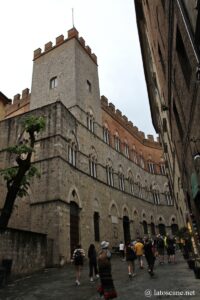
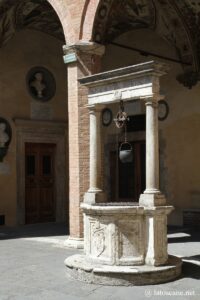
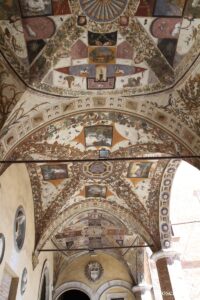
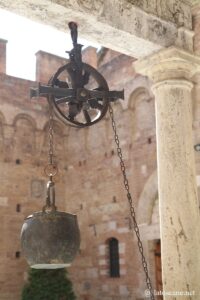
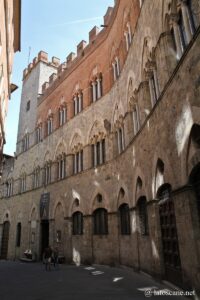
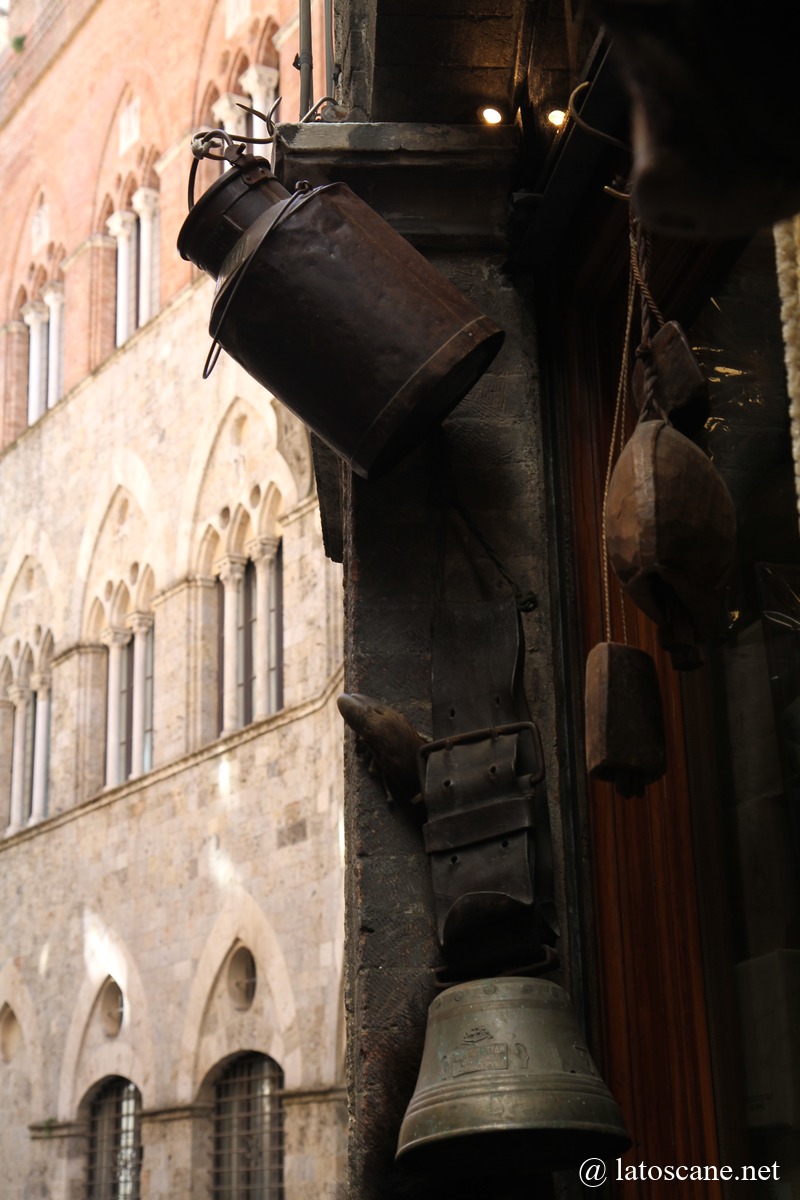
Tolomei Palace in Siena
In the square of the same name, the Palazzo Tolomei was the palace of the family Tolomei, a family that arrived in Italy with Charlemagne. It was one of the first families to practice currency exchange, becoming a powerful family of bankers, Having many properties from the Montagnola Sienese to the Maremma.
Its construction dates at least from the beginning of the thirteenth century and was the oldest private residence in Siena, rebuilt after 1267 when the Ghibellines destroyed it. Its stone façade is typical of the 13th century.
Sansedoni Palace in Siena
The Palazzo Sansedoni is often the most noticed on the Piazza del Campo, after the Palazzo Pubblico. It is one of the best examples of architecture in the late thirteenth-fourteenth centuries. It was built at the end of the 13th century by the Sansedoni in a group of 5 houses, with a curvilinear façade that follows the shape of the square.
The interior has 18th century frescoes and decorations. It now houses the Monte dei Paschi di Siena Foundation, the foundation of the prestigious Sienese historical bank, the oldest in the world.
The chapel is a rare and magnificent example of Baroque in Siena.
Guided tours are available, upon reservation, for groups of at least 15 people.
Piccolomini Palace and Museo delle Biccherne
The Palazzo Piccolomini in via Banchi di Sotto is one of the most beautiful examples of the Renaissance in Siena with its elegant stone facade. It was designed by Bernardo Rossellino, also the architect of the magnificent Piccolomini Palace in Pienza.
It houses the State Archives and the Biccherna Tablets Museum (Museo delle Biccherne). The Biccherna was the main financial magistracy of the city from 1257 to 1786. The tablet are the painted covers on their accounting records. Simple in origin, they became true works of art. These pieces are rare and remarkable, with religious and civil scenes that testify to the social evolution of Siena.
The collection has nearly one hundred painted tablets ranging from the Middle Ages to the early eighteenth century.
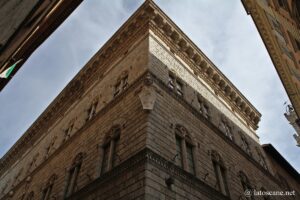
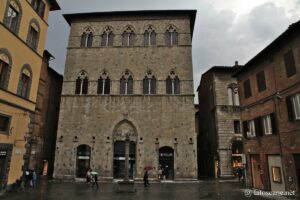
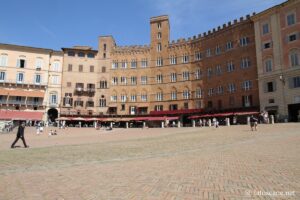
Mount of Pastures
Buonsignori Palace in Siena
Located in Via San Pietro, the Palazzo Buonsignori together with the Palazzo Brigidi hosts the Pinacoteca Nazionale di Siena.
It was built in the 15th century by the banker Giovanni Bichi de Guccio. It is a large late Gothic building, one of the most beautiful palaces in the city. In 1459 it was sold to Tegliacci, then in 1476 to Buonsignori.
Salimbeni Palace in Siena
The Palazzo Salimbeni is a neo-Gothic palace, home of Monte dei Paschi di Siena, the oldest bank in the world.
It was built in the fourteenth century by enlarging a palace of the Salimbeni family, important family of the Ghibelline faction, opposed to the Tolomei, which became the richest of the city, through the Maremma agricultural trade and lending activities. The Salimberi ruled over Valdorcia, part of Maremma and Valdichiana. Called at the time the Castellare, this palace welcomed Charles IV in 1355, and the wife of the brother of the King of France Charles de Valois gave birth here.
In the 15th century, the Republic of Siena employed it as Salt and Gabelle Bureau (tax office) and also installed there in 1472 Monte Pio (Mount Pietà), whose role was to counter the practice of usury. In 1866, Monte Pio was integrated into Monte dei Paschi (literally the Mount of Pastures in English), which granted loans by earning annual public revenues from the pastures of the Maremma. Monte dei Paschi made this palace his seat in 1866. It was rebuilt in neo-Gothic style in 1877.
The interior has a spectacular staircase restored in 1972. It also preserves an extraordinary collection of paintings from the 14th to the 19th century.
The palace opens only three times a year: on the morning of 2 July, on the occasion of the Palio, on the morning of 15 August, the first Saturday in October. The rest of the time you can see an inner courtyard and some rooms.
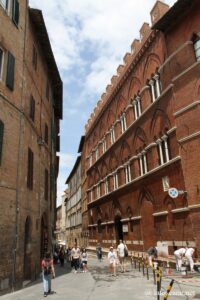
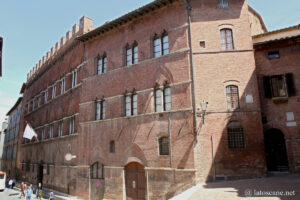
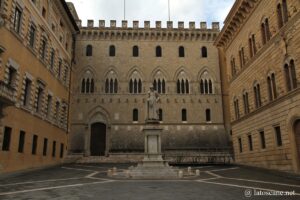
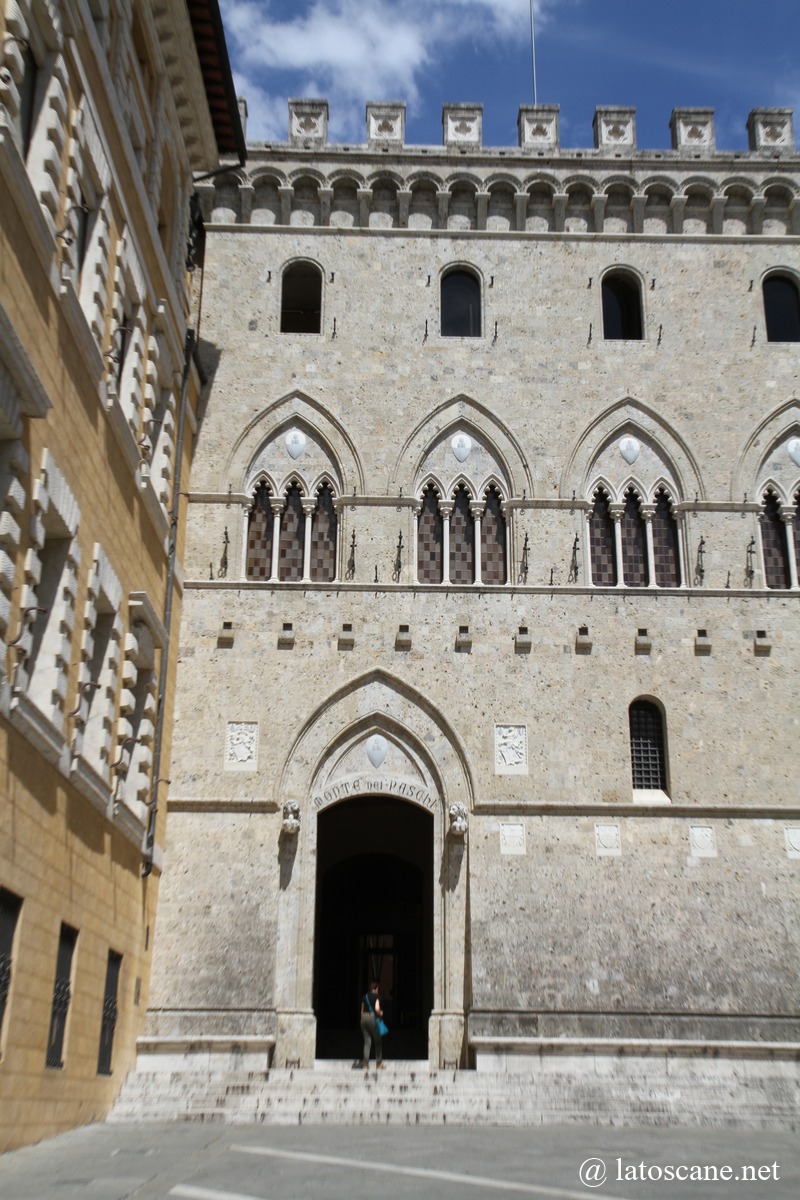
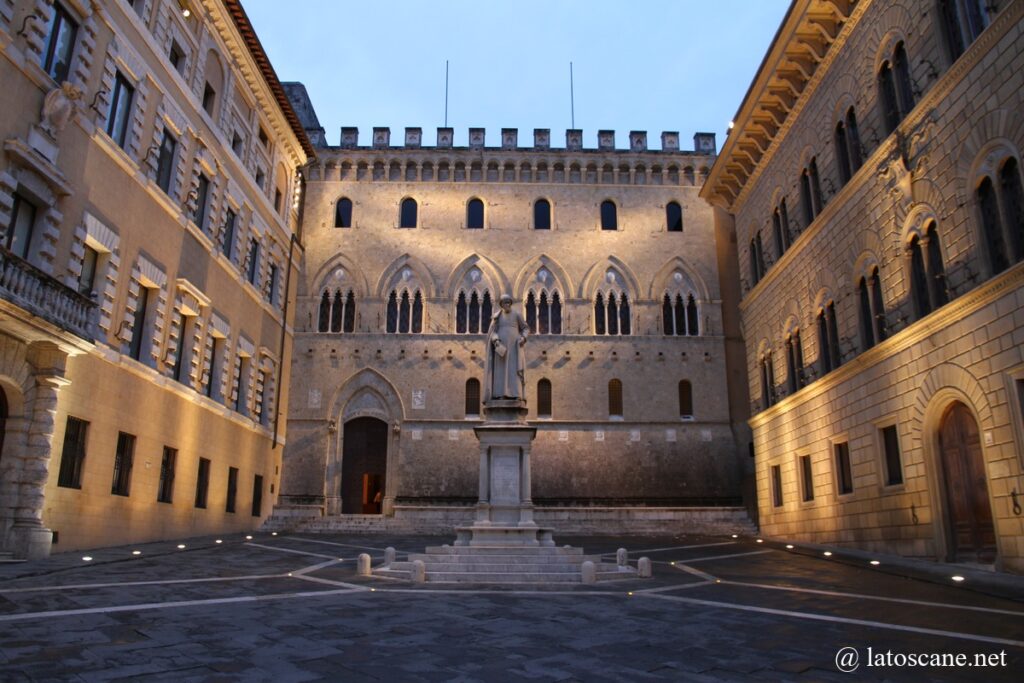
Palace of the Papacy women
The Palazzo delle Papesse (Palace of the Papacy women in English) is located in via di Città, of papal origin, and today houses the Centro per l’Arte Contemporanea Senese.
Built between 1460 and 1495, it is another Piccolomini Palace. It displays a Florentine Renaissance style with its typical stone facade with props
It is nicknamed the Palazzo delle Papesse from Catherine and Laudomia Piccolomini, sisters of Pope Pius II, the Sienese pope who was born in Pienza and rebuilt the historic centre of the city. Catherine directed the construction of the palace, carried out by Bernardo Rossellino, the favorite architect of Pope Pius II.
In 1633, the palace had Galileo as a guest, who was under house arrest after his conviction by the Inquisition.
After the disappearance of the Piccolomini, the palace was leased to the Tolomei in the seventeenth century. In the 19th century, the Office of the Royal Manufactures and State Offices were established there. It was bought by a bank late nineteenth century, renovated occasionally with neo-Renaissance style frescoes. Since 1998 it has been home to the contemporary art centre.
Chigi Zondadari Palace
The beautiful Palazzo Chigi Zondadari is located in Piazza del Campo, built in 1724 on the site of 14th and 16th century buildings that were owned by the merchant families and craftsmen Mezolombardi and Rinaldini, then in the 16th century by the Cennini and at the end of the 17th century by the Chigi.
It was built by the Roman architect Antonio Valeri, the last pupil of Gian Lorenzo Bernini.
It is therefore typical of 18th-century Roman architecture, with its linear style, an interior with large halls decorated with frescoes by renowned painters.
In 2022, the Casa Museo Palazzo Chigi Zondadari was opened to the public to discover the palace and its works.
Palazzo Reale of Siena
The Palazzo Reale (Royal Palace in English) is opposite the Cathedral of Siena on piazza Jacopo della Quercia. It was built in the second half of the 15th century, then called Palazzo Petrucci.
It was rebuilt at the end of the 16th century by the Medici family who made it one of the symbols of their domination over Siena. It is now the seat of the prefecture of the Province of Siena.
Palace of the Archdiocese of Siena
The Palazzo dell’arcivescovado di Siena is located on Piazza del Duomo to the left of the Cathedral of Santa Maria Assunta. Its facade is from the eighteenth century but has kept the Sienese Gothic style of the fourteenth century, with a lower level striped black and white stripes, and above a brick level.
Palace of the Devils
Beyond the Porte Camollia, this Palace of the Devils has a name of mysterious origin. One hypothesis associates it with satanic rites that took place there, another to the Sienese victory of 1526 over the armies of the pope and Florence where diabolical forces would have supported them.
It was a residence of the Buonsignori and would have hosted craftsmen and a tavern.
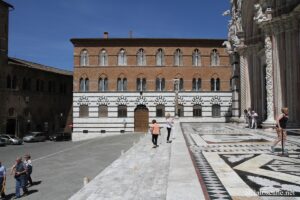
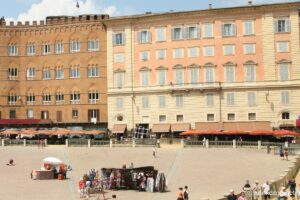
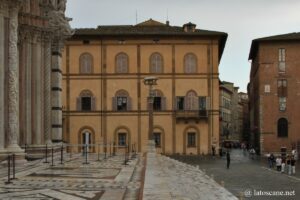
Map with palaces of Siena
If you see this after your page is loaded completely, leafletJS files are missing.
Sources and links
- Tourist portals : palazzoravizza.it, visitsienaofficial.it
- Informations : en.wikipedia.org
Articles about Siena
- Siena
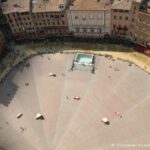 Siena is with Florence one of the most attractive destinations in the region. City of the famous palio, an equestrian race, it is a unique medieval town located in the ...
Siena is with Florence one of the most attractive destinations in the region. City of the famous palio, an equestrian race, it is a unique medieval town located in the ... - Things to do and see in Siena
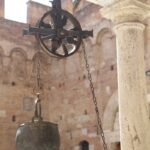 Siena deserves plenty of days to measure its charm. However, it is not a very large city and two days can be enough to bring back beautiful memories. Piazza del Campo ...
Siena deserves plenty of days to measure its charm. However, it is not a very large city and two days can be enough to bring back beautiful memories. Piazza del Campo ... - Piazza del Campo in Siena
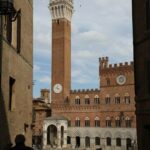 The Piazza del Campo is undoubtedly one of the most beautiful and elegant squares in the world, built between 1293 and 1349. It is the heart of the city of ...
The Piazza del Campo is undoubtedly one of the most beautiful and elegant squares in the world, built between 1293 and 1349. It is the heart of the city of ... - Siena Cathedral
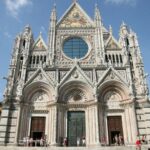 The Siena Cathedral dedicated to Assumption of Mary (Cattedrale di Santa Maria Assunta in Italian) stands out for its white and black stones and marble is certainly one of the ...
The Siena Cathedral dedicated to Assumption of Mary (Cattedrale di Santa Maria Assunta in Italian) stands out for its white and black stones and marble is certainly one of the ... - Palazzo Pubblico in Siena
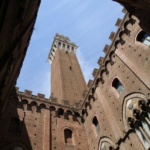 The most imposing building in Piazza del Campo is the Palazzo Pubblico with the very large tower next to the Torre della Mangia. Also called Communal Palace, it was built ...
The most imposing building in Piazza del Campo is the Palazzo Pubblico with the very large tower next to the Torre della Mangia. Also called Communal Palace, it was built ... - Civic Museum of Siena
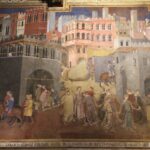 The Siena Civic Museum, the Museo Civico, was built in the 1930s on the first and second floors of the Palazzo Pubblico. Its visit (about an hour) is highly recommended, ...
The Siena Civic Museum, the Museo Civico, was built in the 1930s on the first and second floors of the Palazzo Pubblico. Its visit (about an hour) is highly recommended, ... - Palio di Siena
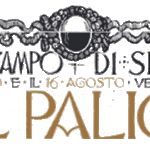 The Palio of Siena is a famous equestrian race that pits the different districts of the city (called the contrade), whose origins date back to the medieval games, held on ...
The Palio of Siena is a famous equestrian race that pits the different districts of the city (called the contrade), whose origins date back to the medieval games, held on ... - Santa Maria della Scala Hospital
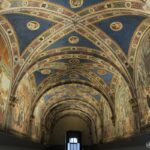 The ancient hospital for pilgrims, Santa Maria della Scala, is home to a vast and rich museum complex in Siena that covers 19,000 m 2. It is an essential step ...
The ancient hospital for pilgrims, Santa Maria della Scala, is home to a vast and rich museum complex in Siena that covers 19,000 m 2. It is an essential step ... - Fountains and bottini of Siena
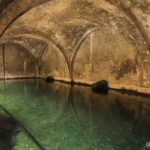 In Siena there are some fountains, fed by the bottini, the galleries of a medieval underground aqueduct built from the 12th century. These galleries are 25 km in length, channelling ...
In Siena there are some fountains, fed by the bottini, the galleries of a medieval underground aqueduct built from the 12th century. These galleries are 25 km in length, channelling ... - Pinacoteca Nazionale in Siena
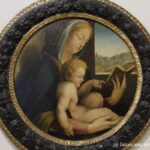 The Pinacoteca Nazionale di Siena is an important Italian museum, especially for its collection of ” paintings on gold background ” from the 14th and 15th centuries in Siena. It ...
The Pinacoteca Nazionale di Siena is an important Italian museum, especially for its collection of ” paintings on gold background ” from the 14th and 15th centuries in Siena. It ... - Basilica of San Dominico in Siena
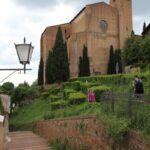 The Basilica di San Domenico in Siena, also known as Basilica Cateriniana, is one of the most important churches in the city, with its imposing Gothic architecture and Renaissance works. ...
The Basilica di San Domenico in Siena, also known as Basilica Cateriniana, is one of the most important churches in the city, with its imposing Gothic architecture and Renaissance works. ... - Saint Catherine Sanctuary in Siena
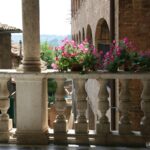 The Sanctuary of Saint Catherine of Siena (Santuario-Casa di Santa Caterina) is located on Hill San Antonio in Siena, consisting of the old house of the Benincasa, the family of ...
The Sanctuary of Saint Catherine of Siena (Santuario-Casa di Santa Caterina) is located on Hill San Antonio in Siena, consisting of the old house of the Benincasa, the family of ... - Other churches in Siena
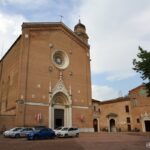 Basilica of Saint Francis in Siena The Basilica of San Francesco di Siena is one of the most important churches in Siena, located on the homonymous square. Between 1228 and 1255, ...
Basilica of Saint Francis in Siena The Basilica of San Francesco di Siena is one of the most important churches in Siena, located on the homonymous square. Between 1228 and 1255, ... - Gates and other sights of Siena
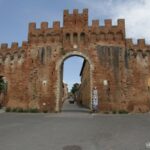 This page is dedicated to other interesting places in Siena, including its walls and gates, loggias, the Medici Fortress, some squares and streets of the center. Walls and gates of Siena Siena ...
This page is dedicated to other interesting places in Siena, including its walls and gates, loggias, the Medici Fortress, some squares and streets of the center. Walls and gates of Siena Siena ... - Tickets and guided tours in Siena
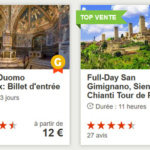 Tickets and proposals for guided tours in Siena, entrance tickets, city tours, with the cathedral complex, Piazza del Campo, excursions in the surrounding area, activities, etc Into the same category
Tickets and proposals for guided tours in Siena, entrance tickets, city tours, with the cathedral complex, Piazza del Campo, excursions in the surrounding area, activities, etc Into the same category - Interactive map of Siena
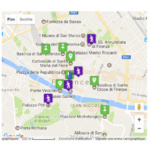 Carte de Sienne interactive avec les principaux monuments et les lieux secondaires, églises, palais et musées
Carte de Sienne interactive avec les principaux monuments et les lieux secondaires, églises, palais et musées - Hotels and accommodations in Siena
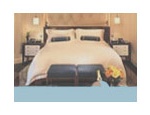 Book now accommodation in Siena, between hotel, rooms and apartments. Hundreds of choices with customer ratings
Book now accommodation in Siena, between hotel, rooms and apartments. Hundreds of choices with customer ratings - Short history of Siena
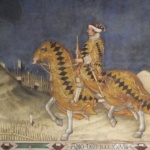 Although it seems that the Etruscans had occupied the territory of Siena, its foundation dates from the time of the emperor Augustus where a Roman colony was established under ...
Although it seems that the Etruscans had occupied the territory of Siena, its foundation dates from the time of the emperor Augustus where a Roman colony was established under ...
No Comments Yet